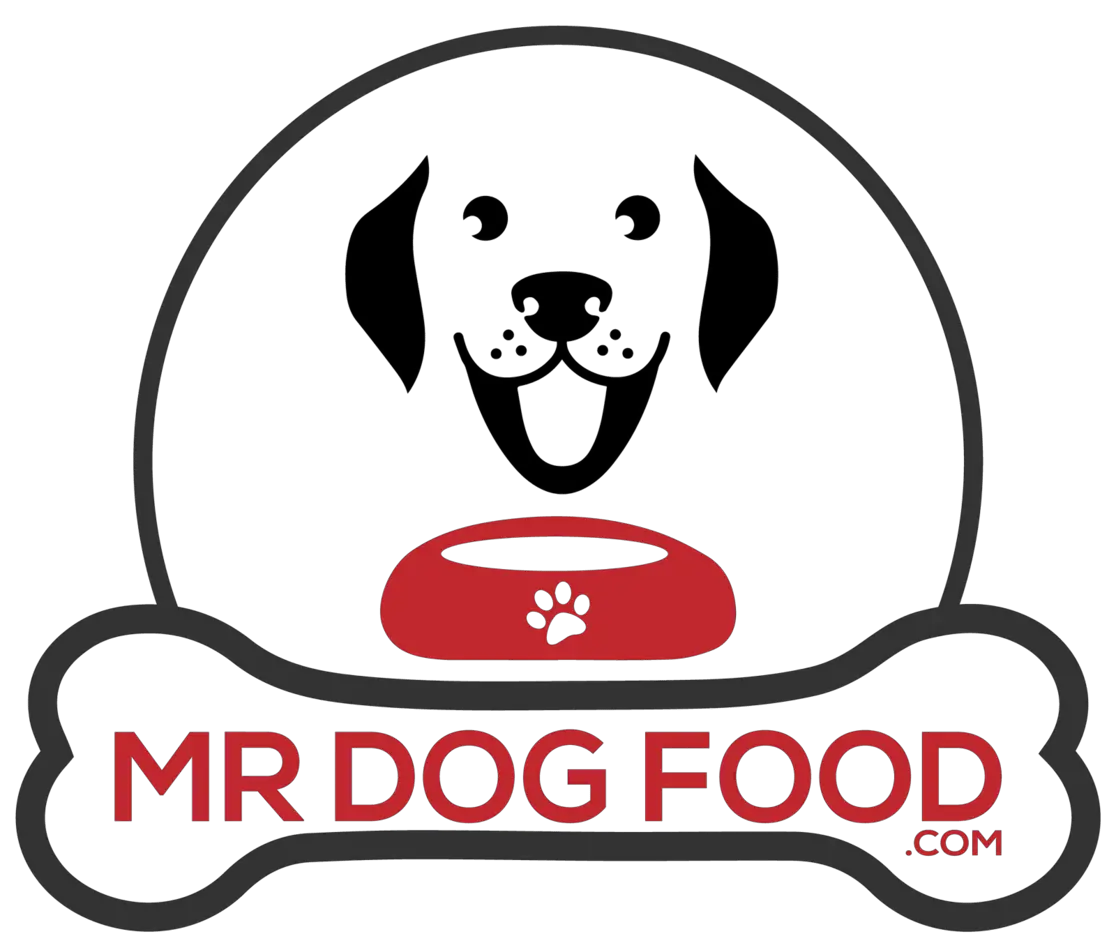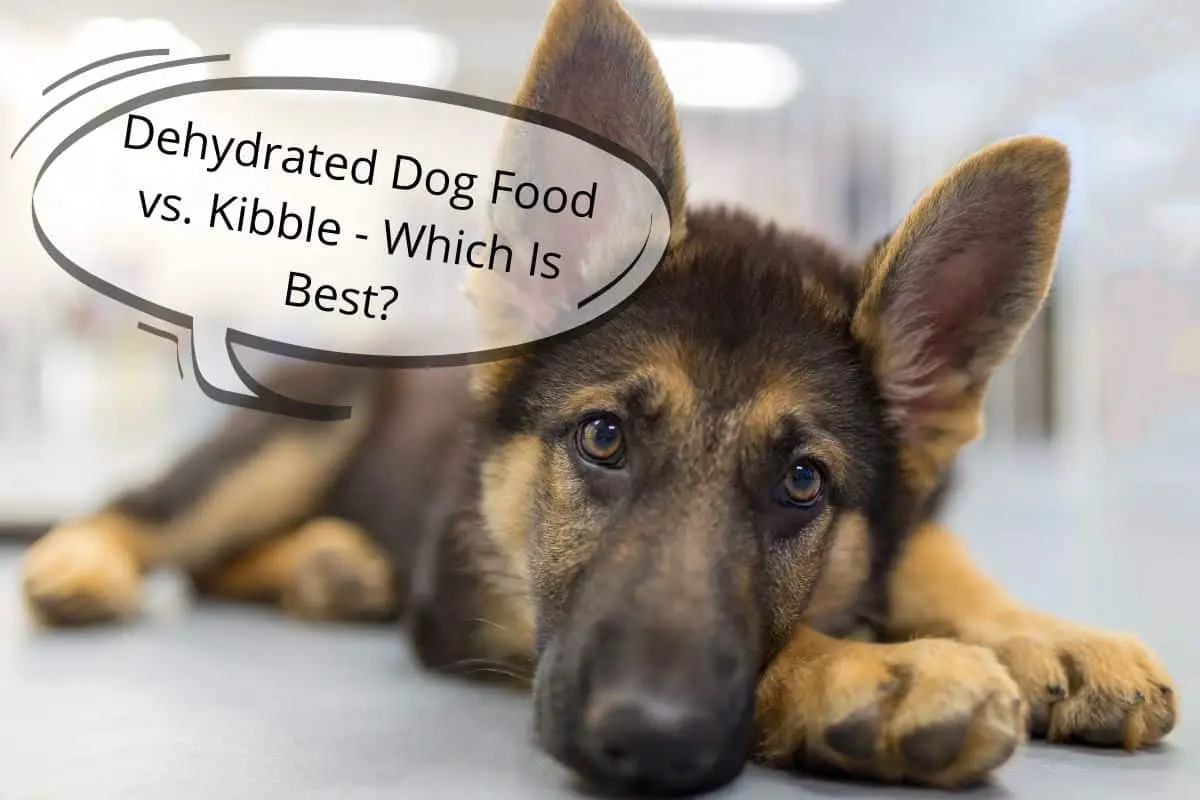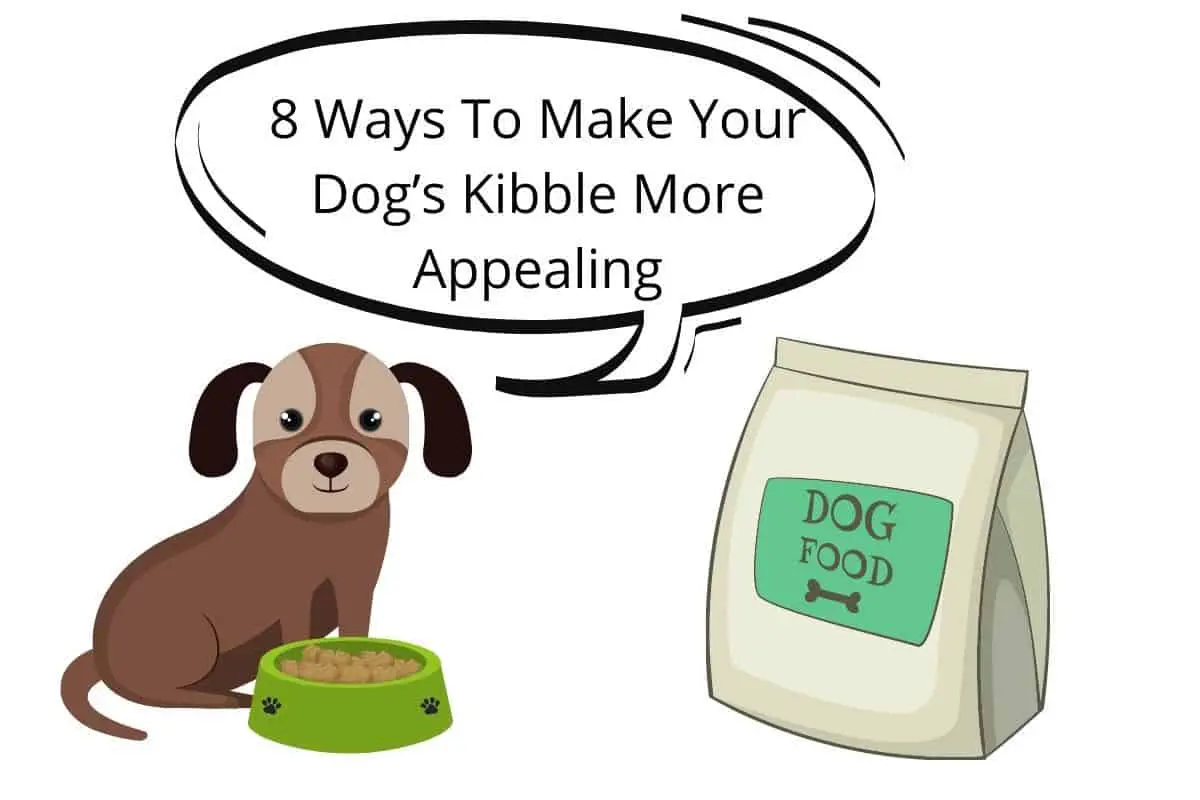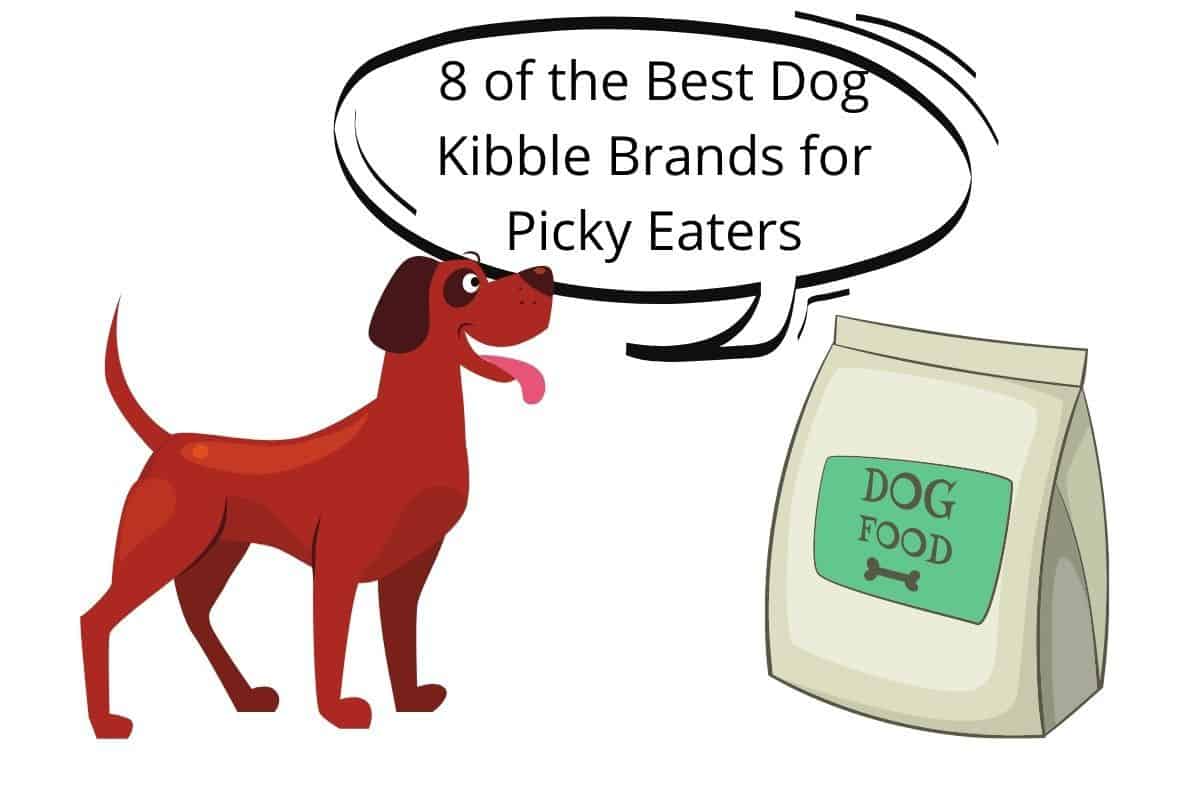This post contains affiliate links.
Most people agonize over picking the dog food that meets their dog’s nutritional needs, like dehydrated dog food and kibble. Is dehydrated dog food better than kibble? Which is the best for your dog?
Dehydrated dog food is better than kibble because it’s more nutritious, tastier, and healthier. Dry foods are only heated to remove moisture while locking in nutrients, flavor, and enzymes. Kibble has lower nutritional value since it’s carb-heavy and processed at high temperatures.
In this piece, you’ll learn more about each of these dog foods and explore their strengths and shortcomings to ensure that you make the right call for your canine friend.
Table of Contents
What Are a Dog’s Nutritional Needs?
Insights into your dog’s nutritional needs are essential to keeping your canine friend strong and healthy. It also lets you breeze through the process of buying the best dog food.
As with most mammals, dogs need various nutrients for healthy growth and development. These nutrients include amino acids, vitamins, fatty acids, carbohydrates, water, and minerals.
While most nutritional guides describe the recommended dietary nutrients to keep a dog healthy, they paint in broad strokes. A dog’s dietary needs depend on its breed, size, stage in life, and health status, among other factors.
Understanding the role nutrients play in a dog’s life, the necessary quantities, and daily requirements are essential to choosing the best foods:
- Proteins and amino acids. The best diets are rich in proteins that provide the ten essential amino acids. Naturally, dogs prefer food high in protein and avoid foods lacking all the amino acids.
- Fats and fatty acids. Whether derived from animal fats or seed oils, fatty acids are crucial to cell function and structure while enhancing dog food’s taste and texture.
- Vitamins. Dogs require vitamins in low concentrations, and too much of them can be harmful. The best dog food diets strike a delicate balance between the 12 essential vitamins.
- Minerals. The best dog foods contain the 12 essential minerals a dog needs, including phosphorus, calcium, sodium, magnesium, and potassium.
The ideal dog food lets your dog meet the daily nutritional requirements with each serving.
What Is Dehydrated Dog Food?
Dehydrating is the oldest food preservation method known to man; hence it’s only fitting that he extends it to his best friend. It’s the cheapest, healthiest, and easiest way to preserve fresh food.
Drying fresh food requires heating it over low heat to remove the water content, much like sun drying. The dehydration process mimics the sun, but it occurs in a controlled environment.
Dehydrated dog food has all the benefits of raw unprocessed foods, including high nutrients bioavailability and minimal processing. It combines the best of dry and wet dog foods since the dehydration process preserves all the nutrients and goodness your pet needs to stay healthy.
How Is Dehydrated Dog Food Made?
So, how is dehydrated dog food made? The process entails removing moisture from the dog food by blowing hot or warm air around it. The low heat partially cooks the food but not enough to alter its structure and taste; hence, dehydrated food isn’t raw.
Gently heating the food over low heat cooks the protein without ruining its nutritional value. That’s because removing food’s moisture content at low temperatures preserves most nutrients while giving the food extended shelf life.
Circulating warm, dry air reduces the food’s moisture content and stops the growth and multiplication of pathogens found in raw ingredients, such as meats.
Dehydrating foods — even in a commercial setting — has minimal effects on the nutritional value. Drying food is among the healthiest and least damaging food preservation methods known to mankind.
While the production method lends numerous health benefits to dehydrated dog food, the ingredients determine its quality. The food components used, how they react to heat, their proportions, and combination determines how nutritious the food is.
The process of combining ingredients in dehydrated dog food creates room for potential deficiencies and excesses. Hence, you must check the label carefully to ensure that you’re getting the best ingredients and combinations.
Why Is Dehydrated Dog Food Popular?
Dehydrated dog food is popular with dog owners because of its superior quality and convenience. Since the food loses a slight fraction of its nutritional value, adding warm water rehydrates the dog food to restore its natural goodness.
When restored, dehydrated dog food resembles a home-cooked dog meal but without the risk of over or undercooking.
Restoring dehydrated dog food before serving transforms it into wet dog food, which is easier to digest and chew. The high moisture content means the dog won’t drain much of its body fluids when digesting the food.
Moisture removal affects the dehydrated food’s texture and taste, but the effect is negligible since most dogs relish the restored food and gobble it quickly.
You can also rehydrate two or three days’ worth of dog food and preserve it in the fridge for greater convenience.
Pros of Dehydrated Dog Food
- Healthier. The dehydrating process has minimal effects on the nutritional content of the ingredients. Your pet gets to enjoy the wholesome goodness and nutritional value of all the ingredients in the food. The simple preservation method eliminates the need for unnecessary ingredients. Each item in the dehydrated dog food contributes to your dog’s health and well-being.
- Minimal processing. Dehydrated dog food is cooked at low temperatures that don’t denature proteins, gelatinize carbs, or ruin the vitamins. Minimally processed ingredients are packed with goodness and are easier to digest while keeping your dog’s digestive system healthy.
- Easy to store. Since dehydration removes over 95% of the moisture, dehydrated dog food is relatively lightweight. It ships in handy packets or containers that don’t require specialized storage. You can stow the dog food in a cool dark place, such as a lockable pantry or cupboard.
- Easy to transport. Dehydrated dog food makes it easy to feed your pet while you’re on the move since it’s not bulky and doesn’t require special storage. You can stash the food in a backpack or the trunk of your car when heading out. The lightweight nature means you can also buy the food from an online retailer without incurring high shipping costs.
- Safe alternative to raw foods. This dog food is pre-cooked to preserve its taste and nutrition. Cooking over low temperature means the proteins won’t break down, allowing them to provide the same benefits as raw dog food. However, the minimal processing kills pathogens to make the food easy to handle while eliminating your dog’s chances of becoming sick.
- Quality ingredients. Unlike kibble, dehydrated dog food doesn’t include unnecessary ingredients. Each item in the formula is picked for its nutritional value and benefits to your dog. The lack of filler ingredients makes dehydrated dog food a prime source of nourishment for your dog.
- Easier to digest. You must restore dehydrated dog food with hot water before serving it to your pet. Adding the water transforms it into an easy-to-digest wet meal. Wet dog food is filling and easy on the digestive system while helping with weight loss since it takes longer to digest.
- No additives. Since each ingredient in a dehydrated dog formula is bone-dry, there’s no need for chemical additives and preservatives. Each item in the formula retains its original taste and smell. That eliminates the need for artificial flavors and coloring, which can be harmful in the long term.
- Easy preparation. Covering the day’s ration with hot water and letting it cool is all the prep time you need to feed your dog. You can have a delicious meal for your canine friend ready to go in five minutes.
- Lasts long. Since you must rehydrate each portion before serving, a bag of dehydrated dog food can last you a long time. Restored dog food chunks swell to about double their size on absorbing the water. You only need to restore a small portion of the dry food to feed your dog.
- Safe to handle. Unlike raw dog food, dehydrated dog food is free from harmful pathogens that could make you sick. While it’s advisable to maintain good hygiene, such as washing your hands, you don’t need an elaborate clean-up after each feeding session.
- Dogs find it yummy. Even picky eaters love dehydrated pets because the ingredients retain their original taste and smell. It affords them a chance to munch on some of their favorite bites.
- Contains a variety of protein sources. Dehydrated foods use different protein sources, including beef, buffalo, chicken, salmon, duck, and more. A little experiment can zero in on your pet’s preferences.
Cons of Dehydrated Dog Food
- Quality varies among manufacturers. While some firms use superior ingredients in their formula, others tend to use cheap ingredients. Checking the labels and sticking to reliable brands is the best way to keep your pet healthy.
- Pricey. Dehydrated foods aren’t the most affordable canine diets on the market. However, they fall in the middle of the dog food price spectrum and may cost the same as some high-end kibble brands.
- May contain pathogens. The heat used to pre-cook the food isn’t high enough to kill all the pathogens. Sticking to reputable brands helps to avoid or minimize this risk.
- Messy. Dogs often create a mess when consuming wet foods and call for a clean-up after each feeding session. It’s advisable to clean the feeding bowl before each meal to avoid the risk of food poisoning.
What Is Kibble?
Kibble is a readily available processed dog food comprising ground ingredients shaped into pellets or nuggets. Pet food manufacturers ground meat, vegetables, grains, oils, binders, and other items to make kibble.
Common protein sources in kibble include poultry, beef, fish, and eggs. They also have starch derived from cereals, minerals, vitamins, and antioxidants. Dry dog foods such as kibble require preservatives to keep the fats from going rancid.
How Is Kibble Made?
The mixed raw ingredients are cooked under high pressure and temperatures to make kibble. The cooked pet food is then extruded through a die to give it unique shapes.
The extrusion cooking technology creates kibble with a 200-300 g/kg moisture level. The wet kibble is dried at high temperatures to reduce the moisture content between 60 and 90 g/kg to prolong shelf life.
This production method’s benefits include excellent pasteurization, density control, nutrient retention, and flexibility.
Kibble’s raw ingredients often cook at 340°F (171°C) and 2-3 bars of pressure for up to 15 seconds inside an extruder. The high temperature and pressure cooking are one of the kibble’s primary shortcomings, lowering its nutritional value.
Why Is Kibble Problematic?
Compared to other pet foods, kibble is a carb-heavy diet since it comprises up to 40% starch. The manufacturing process calls for high starch and carbohydrates content because it doubles up as a binding agent.
When exposed to high temperatures, starch melts or gelatinizes and holds the ingredients together. That makes it easy to shape and mold the kibble into various shapes and sizes.
Most of the starch used in kibble is derived from cereal grains, which are not ideal for dogs. A high starch diet poses a danger to pets struggling with diabetes as it causes massive blood sugar levels after consumption.
High heat also changes the structure of the protein in the kibble – a process known as denaturation. A change in the protein structure can make it less digestible and may result in food allergies for dogs.
Your pet’s digestive may not recognize the new protein structure and hence will treat it as a disease-causing element. Denaturalization is why some pets are allergic to some dry foods with a certain meat but can eat the raw meat with no problem.
The high heat also causes the ingredients to lose their flavors, forcing pet food manufacturers to use artificial flavors. Despite such notable shortcomings, kibble is the most popular dog food on the market because it comes with numerous advantages.
Pros of Dog Kibble
- Affordable. Kibble is the cheapest dog food on the market to let you keep your pet well-fed at any budget. This dog food is readily available at the supermarket, pet shop, and even online. However, the price spectrum determines the quality of kibble and the ingredients in the dog food.
- Convenient. Kibble requires no prep time since you can serve the dog food straight out of the package into your pet’s bowl. This option is ideal for busy pet parents looking to ensure their dog is always well-fed. You can leave the kibble out on the dog’s bowl when going away without the risk of food poisoning.
- Broad choices. Kibble is a wildly popular commercial dog food in many regions; hence you have a limitless choice. Kibble brands span across a broad price spectrum and help feed your pets without ruining your finances. The dog food comes in various packages and keeps for a long time.
- Ready to eat. Kibble is a complete dog meal on the go that addresses every part of your pet’s nutritional needs. They’re formed in various shaped and sized crunchy nuggets that dogs love to nibble on.
- Guarantees nutritional completeness. The USDA requires kibble manufacturers to provide a balanced and nutritious dog meal. Each recipe must contain a protein source, vitamins, minerals, grains, and antioxidants. Some recipes are formulated for dogs with specific health issues.
- Long shelf life. As a dry dog food, kibble has a long shelf life and will keep for a long time. You can shop in bulk to keep your costs low without running the risk of dog food spoilage. An open bag of kibble can keep for months without losing its freshness.
- Easy storage. Kibble is easy to store since you only need to keep it in a cool dark place. Most ship in heavy and opaque paper bags, so you can store them in your pantry or cupboard without worrying about light. Kibble won’t take up valuable space in your freezer.
- Highly customizable. Manufacturers formulate kibble formulas to suit different dog nutritional needs. There are special formulas for different breeds, life stages, allergies, and other health requirements. The broad selection makes it easy to cater to a dog with special dietary and nutritional needs.
- Pathogen free. Kibble is processed and cooked under high temperatures to gelatinize the carbs, which doubles as a kill step. That kills all pathogens found in raw ingredients — such as meat — to deliver a safe variety of dog food.
- Safe to handle. Kibble comes in small, highly processed nuggets that are safe to handle with your bare hands. You can hand-feed your dog kibble without worrying about bacteria or risking an infection. No thorough clean-up is necessary after a kibble feeding session.
- Different tastes and flavors. Kibble comes in many flavors to give your dog numerous options. The options make it easy to cater to picky eater’s needs while ensuring that your dog doesn’t endure the same dog food flavor all year round. You can vary the flavor and transform each mealtime into a tail-wagging feast.
- Improved dental health. The hardy chewy kibble nuggets are great for your dog’s dental health since they prevent plaque buildup. Chewing on tough items cleans the teeth while keeping the dog’s gum healthy and teeth strong.
Cons of Dog Kibble
- Inferior ingredients. Since the ingredients are mixed and ground together and laced with additives and flavors, some brands get away with using subpar ingredients. Some use meat by-products and unnecessary fillers in their formulas.
- Carb-heavy. Kibble comprises up to 40% carbohydrates because the starch doubles as the binding agent. The high carb content is unhealthy and could lead to unhealthy weight gain and increase the risk of diabetes.
- Impossible to tell the ingredients. The ingredients are pulverized before the extrusion process, and artificial flavors cover the remaining taste. The label is the only way to identify the food components, but some shady brands list the wrong ingredients.
- Low nutritional value. High heat during the production process scotches and depletes most of the nutrients in the kibble. Feeding your dog exclusively kibble could lead to dietary deficiencies in the long run.
- Dry. Dry foods are hard on a dog’s digestive system and increase the likelihood of bloating and dehydration. They force the dog to channel most of their body fluids into the stomach to assist the digestive process.
Dehydrated Dog Food vs. Kibble: Which One Should You Pick?
Dehydrated dog food provides healthy, nutritious, and tasty sustenance for your dog. The food undergoes minimal processing and doesn’t contain unnecessary fillers or ingredients. Drying preserves most of the nutrients, and the ingredients retain their original taste, smell, and flavor.
With kibble, the ingredients are pulverized and cooked under high heat and pressure. The resultant product bears no traces of the original components, and it’s laced with flavor and other additives to make it appealing to pets. The pet food is high in starch but often contains added macro and micronutrients to meet a dog’s nutritional requirements.
Dehydrated dog food makes a better diet for your pet since it is more beneficial, highly nutritious, and contains no fillers, additives, and preservatives. You can feed it to your canine friend without putting their health and well-being at risk.
Kibble is best suited as a snack or an occasional snack instead of making it your dog’s regular meal. A sustained kibble diet could lead to serious health problems, including diabetes and unhealthy weight gains.
Final Thoughts
Dehydrated dog food is the best choice when looking for a sustainable and healthy way to feed your dog. The dog food is rich in nutrients, comes in various tasty flavors, and is free from harmful chemicals.
It combines the goodness and convenience of a raw dog diet minus all the risks and handling precautions. You can have the pet food ready to go in minutes.
Kibble is a dog’s equivalent to a fast-food diet. It may be delicious and tail-wagging good, but it’s quite unhealthy. It’s high in carbohydrates, fillers, and preservatives that could compromise your pet’s health and well-being.
Sources
- Healthy Cells Magazine: Advantage of Dehydrated Pet Food
- K9 Magazine: What is Dehydrated Dog Food & is It Good for Dogs
- Pup Ford: Dehydrated Dog Food: The Ultimate Guide
- Paw Tracks: Freeze-dried Vs Dehydrated Dog Food: Which is Best?
- The Honest Kitchen: Benefits of Raw Vs Dehydrated Pet Foods
- Whole Dog Journal: Which Type of Dog Food is Best?
- PupFord: Kibble Vs Dehydrated Dog Food Vs Raw Diets
- American Kennel Club: Fresh Vs Raw Vs Kibble: What Should You Feed Your Dog?
- Feeding My Dog Breed: What is Kibble?
- My Ollie: The Goldilocks Rule of Cooking Dog Food
- Pledge Care: The Consequences of High Temperatures in Pet Food
- Truth about Pet Food: New Study Finds Drying Time of Kibble Lessens Nutritional Value
- Paw Friendly: The Pros and Cons of Feeding Dehydrated or Freeze-Dried Dog Foods
- Whole Dog Journal: Complete and Balanced Dehydrated Dog Foods
Mrdogfood.com is a participant in the Amazon Services LLC Associates Program, an affiliate advertising program designed to provide a means for sites to earn advertising fees by advertising and linking to Amazon.com. We also participate in other affiliate programs which compensate us for referring traffic.






